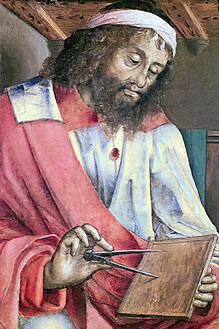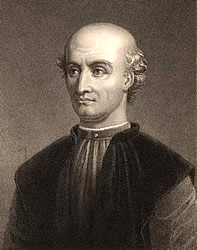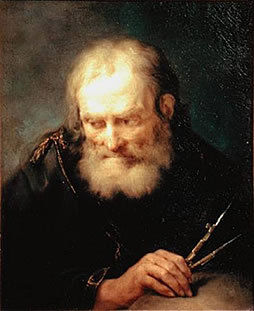| Raphael's
Masterpieces |
|
Bramante
as Euclid or Archimedes |
||
|
Bramante |
Euclid |
Archemedes |
|
Raphael
Santi |
The important aspect of the fresco is that it is believed that Raphael included a number of his contemporaries in the painting. For example, it has been suggested that the Euclid figure is a portrait of the architect Bramante. In the right foreground, Euclid is seen holding calipers and demonstrating a theorem for a group of students. Each member of the group illustrates a different moment of coming to an understanding of the mathematician instruction their gestures and facial expressions show that each is at a different phase of the process. The
leader of the disputants is a bald old man who closely resembles
the geometrician (variously identified as Euclid or Archimedes)
directly |
Donato
Bramante Donato Bramante, Donato also spelled Donino or Donnino (born c. 1444, probably at Monte Asdrualdo, Duchy of Urbino [Italy]—died April 11, 1514, Rome) architect who introduced the High Renaissance style in architecture. His early works in Milan included the rectory of Sant’Ambrogio and the church of Santa Maria delle Grazie. In
Rome, Bramante served as principal planner of Pope Julius II’s
comprehensive project for rebuilding the city. St. Peter’s
Basilica, of which he was the chief architect, was begun in 1506.
|
|
 |
Euclid Euclid, sometimes called Euclid of Alexandria to distinguish him from Euclides of Megara, was a Greek mathematician, often referred to as the "father of geometry". He was active in Alexandria during the reign of Ptolemy I (323–283 BCE). His Elements is one of the most influential works in the history of mathematics, serving as the main textbook for teaching mathematics (especially geometry) from the time of its publication until the late 19th or early 20th century. In the Elements, Euclid deduced the principles of what is now called Euclidean geometry from a small set of axioms. Euclid also wrote works on perspective, conic sections, spherical geometry, number theory and rigor. Euklides |
|
|
|||||||
|
|||||||
|
|||||||
|
|||||||
|
|||||||
|
|||||||

 Donato
Bramante
Donato
Bramante

